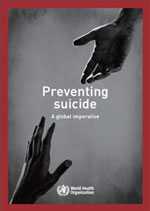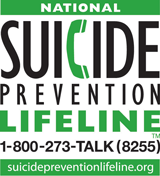Featured Topic: World Health Organization's (WHO) Report on Preventing Suicide
Why Focus on Preventing Suicide Globally?
Suicide is a serious global public health problem. More than 800,000 people worldwide die from suicide every year. For each suicide there are many more people who attempt suicide every year. Suicides are preventable. Multiple sectors, including health, education, labor, agriculture, business and the media have a role to play in suicide prevention.
 What Does the WHO Report on Preventing Suicide Emphasize?
What Does the WHO Report on Preventing Suicide Emphasize?
For World Suicide Prevention Day 2014, observed every September 10th, the World Health Organizations (WHO) launched its first global report on suicide Preventing Suicide: a global imperative. The report
- Presents the latest information and data on suicide and suicide prevention efforts worldwide,
- Identifies evidence-based approaches to suicide prevention that can be adapted to different settings, and
- Encourages strategic, collaborative actions to have the greatest impact.
The report serves as a building block for the development and implementation of comprehensive suicide prevention strategies worldwide.
What Is the Impact of Suicide within the United States?
Each year, more than 39,000 Americans end their own lives, nearly 500,000 people are treated in U.S. emergency departments for self-inflicted injuries, and 1 million adults report making a suicide attempt. Many more people struggle with thoughts of suicide.
Suicide is a serious public health problem that affects people of all ages. It is the 10th leading cause of death for Americans overall and the second leading cause of death among adolescents and young adults aged 15-29. Suicide and suicidal behavior can have devastating effects on individuals, families, schools and communities.
What Is CDC Doing to Prevent Suicides in the United States?
The Division of Violence Prevention at the Centers for Disease Control and Prevention (CDC) works with many partners to apply the public health approach to suicide prevention. CDC works to:
- Describe and track the problem of suicidal behavior.
- Increase understanding of suicide trends and patterns in the United States.
- Study the causes and consequences of suicidal behavior.
- Evaluate and demonstrate ways to prevent suicidal behavior.
- Communicate scientific information about suicide prevention.
As described in Preventing Suicide: a global imperative, suicidal behavior is a multi-faceted problem that benefits from diverse groups working together. CDC works with federal and non-federal partners to build the knowledge base for suicide prevention and to ensure that the best evidence is being used to guide action. The U.S. developed its National Strategy for Suicide Prevention (NSSP) in 2001 and recently updated it in 2012. CDC actively works with the National Action Alliance for Suicide Prevention to advance the NSSP and to champion suicide prevention as a preventable public health problem.
Preventing Suicide: a global imperative underscores the importance of key issues raised by the NSSP, including the following:
- Improving the timeliness and usefulness of data to guide suicide prevention
- The importance of research to enhance the basis for suicide prevention
- Expanding the range of prevention programs, especially focusing on enhancing protective factors and resilience
- Coordinating suicide prevention activities across sectors and settings
- Getting information about what works out to communities
Need Help? Know Someone Who Does?

Contact the National Suicide Prevention Lifeline
- Call 1-800-273-TALK (1-800-273-8255)
- Use the online Lifeline Crisis Chat.
Both are free and confidential. You’ll be connected to a skilled, trained counselor in your area.
For more information, visit the National Suicide Prevention Lifeline.
- Page last reviewed: August 15, 2016
- Page last updated: August 15, 2016
- Content source:


 ShareCompartir
ShareCompartir
